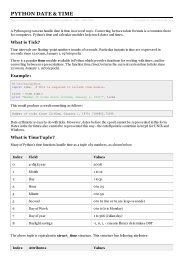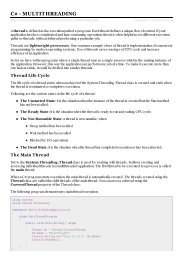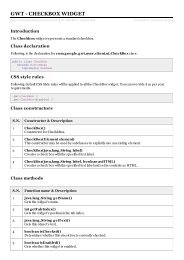Download Scala Tutorial (PDF Version) - Tutorials Point
Download Scala Tutorial (PDF Version) - Tutorials Point
Download Scala Tutorial (PDF Version) - Tutorials Point
You also want an ePaper? Increase the reach of your titles
YUMPU automatically turns print PDFs into web optimized ePapers that Google loves.
elements.<br />
38<br />
39<br />
40<br />
41<br />
42<br />
43<br />
44<br />
45<br />
46<br />
47<br />
def subsetOf(that: Set[A]): Boolean<br />
Returns true if this set is a subset of that, i.e. if every element of this set is also an element of that.<br />
def sum: A<br />
Returns the sum of all elements of this immutable set with respect to the + operator in num.<br />
def tail: Set[A]<br />
Returns a immutable set consisting of all elements of this immutable set except the first one.<br />
def take(n: Int): Set[A]<br />
Returns first n elements.<br />
def takeRight(n: Int):Set[A]<br />
Returns last n elements.<br />
def toArray: Array[A]<br />
Returns an array containing all elements of this immutable set.<br />
def toBuffer[B >: A]: Buffer[B]<br />
Returns a buffer containing all elements of this immutable set.<br />
def toList: List[A]<br />
Returns a list containing all elements of this immutable set.<br />
def toMap[T, U]: Map[T, U]<br />
Converts this immutable set to a map<br />
def toSeq: Seq[A]<br />
Returns a seq containing all elements of this immutable set.<br />
48<br />
def toString(): String<br />
Returns a String representation of the object.<br />
<strong>Scala</strong> Maps<br />
<strong>Scala</strong> map is a collection of key/value pairs. Any value can be retrieved based on its key. Keys are unique in the<br />
Map, but values need not be unique. Maps are also called Hash tables. There are two kinds of Maps,<br />
the immutable and the mutable. The difference between mutable and immutable objects is that when an object is<br />
immutable, the object itself can't be changed.<br />
By default, <strong>Scala</strong> uses the immutable Map. If you want to use the mutable Set, you'll have to<br />
importscala.collection.mutable.Map class explicitly. If you want to use both mutable and immutable Maps in the<br />
same, then you can continue to refer to the immutable Map as Map but you can refer to the mutable set<br />
as mutable.Map. Following is the example to declare immutable Maps as follows:<br />
// Empty hash table whose keys are strings and values are integers:<br />
var A:Map[Char,Int] = Map()<br />
// A map with keys and values.<br />
val colors = Map("red" -> "#FF0000", "azure" -> "#F0FFFF")<br />
While defining empty map, the type annotation is necessary as the system needs to assign a concrete type to<br />
variable. If we want to add a key-value pair to a Map, we can use the operator + as follows:<br />
A += ('I' -> 1)<br />
A += ('J' -> 5)<br />
A += ('K' -> 10)<br />
A += ('L' -> 100)<br />
TUTORIALS POINT<br />
Simply Easy Learning

















